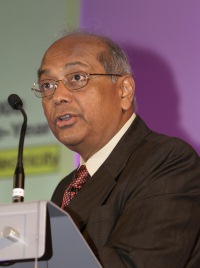French government puts up funds for Astrid
16 September 2010
The government of France has allocated €651.6 million ($837.4 million) to develop a prototype fourth generation fast neutron reactor to be operational by 2020. India's nuclear program also sees neutrons as a valuable resource.
The funding for the Astrid (Advanced Sodium Technological Reactor for Industrial Demonstration) project is the lion's share of €900 million ($1.157 billion) of funding allocated to the Commissariat á l'énergie atomique (CEA) for the development of the "nuclear technologies of tomorrow". (The remaining €248.8 million ($320 million) is allocated to the Jules Horowitz research reactor currently under construction at Cadarache in the south of France). The funding was announced in the French state's official journal in a 12-page document setting out in some detail how the CEA's studies will be conducted over the next decade.
 |
| Srikumar Banerjee addresses the WNA Symposium |
India wants neutrons
Neutrons are a vital energy resource that must not be wasted. That was the message of Srikumar Banerjee, chairman of the Atomic Energy Commission of India and secretary of the country's Department of Atomic Energy, to delegates to the World Nuclear Association's 35th Annual Symposium in London.
With limited uranium resources, sustainability of nuclear energy is of "maximum importance" for India to grow its nuclear energy capacity in line with its development plans, Banerjee said. Central to this are three resources: fissile material, fertile material, and neutrons. India’s long-established three-stage closed nuclear power program exploits all these, with its operational pressurised heavy water reactors building the plutonium inventory to fuel the fast breeder reactors in the second stage, helping to build uranium-233 inventory for use in a third stage of thorium-based reactors yet to come, drawing on India's thorium reserves.
Banerjee described how India's nuclear plans have progressed to date, including development work on thorium fuels and looking forward to a closed-fuel cycle future with high temperature reactors for process heat applications, molten salt reactors and accelerator driven subcritical systems also on its roadmap.
|
According to the announcement, the funding should allow the CEA to prepare a detailed design for the sodium-cooled fast neutron reactor. As well as the reactor itself, the Astrid programme also includes related fuel cycle feasibility studies and other R&D work. Astrid would also have the capacity to be used for actinide burning, transmuting the long-lived and highly radioactive actinides found in spent nuclear fuel from conventional power reactors into shorter-lived and easier-to-dispose species while generating power.
The Astrid program ultimately aims for France to have in place all the necessary elements for industrial deployment of fast reactors starting from 2040. The current funding will cover six sub-programs working towards that goal, including the development of the prototype reactor design, developing or upgrading facilities for technological component qualification, renovation of the CEA's MASURCA critical model so that it can be used in the relevant research, fuel cycle facilities, a program on safety and serious accidents, and feasibility work on the manufacture of actinide-containing fuel assemblies. The Jules Horowitz reactor, due to come online in 2014, will also play a part in the project in terms studying the behaviour of materials and fuels.
The reactor design work will encompass three stages: the first stage of preliminary reactor design work is planned to be completed in 2012, followed by the second stage in 2014 and a detailed design by 2017. Over that period, a total of €337 million ($433.3 million) will be spent on the reactor prototype project, €213.6 million ($274.7 million) on developing or upgrading facilities for technological component qualification, and lesser amounts on the other six sub-projects. The prototype reactor should be operational by 2020.
Fast neutron reactors offer the prospect of vastly more efficient use of uranium resources than in conventional power reactors, as well as the ability to burn actinides. Fast reactors have operated in various countries since the 1950s, with some producing electricity commercially. France itself has operated three such reactors since the 1960s, including Phenix , which operated from 1973 to 2009. The CEA was commissioned by the government to develop two fourth generation fast reactors including Astrid in 2006, and it was decided in 2009 to make Astrid a high R&D priority because of its potential as an actinide burner.
Researched and written
by World Nuclear News